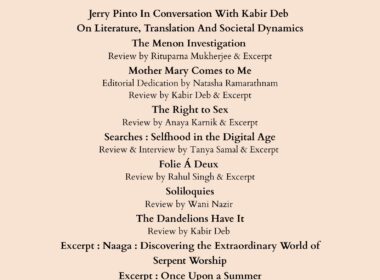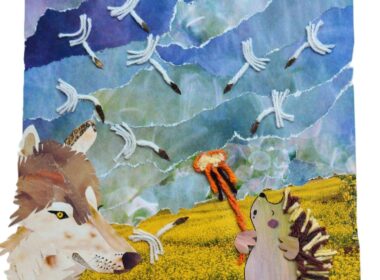The Room Of A Parallel World
Reviewer: Kabir Deb
Image Courtesy of Penprints Publication
Mist gives us a very interesting insight into our lives. Our warm breath meets the outer climate, which is cold, and suddenly the water vapour condenses into tiny liquid droplets which come out of our mouth and nostrils. It is a replica of what happens when clouds cannot bear the weight or mass of water and start to rain – a process of condensation – on a larger scale. It solidifies the thought of Upanishad that says, we are one with Brahman (consciousness), which is divinity spread on a universal level. Human beings develop stories from the Brahman and ease them out like mist. Sohini Sen’s The Dandelions Have It is a collection of moments, which represent the thought of oneness and escalate into the possible realm of fantasy and imagination, to blend nature and mind.
The book is divided into four parts, each of them addressing the four out of five energies which navigate the dynamics of every biotic and abiotic; living and non-living element of nature. The first section is titled as Air, where one short story takes the energy into concern to frame a fantasy fiction that is fuelled by the possibilities of an imaginative mind. In this story, a wolf can speak, hedgehog can blabber philosophy without being philosophical, and all readers need to do is to exchange ideas which are familiar to us, but are seldom applied. Sen brings out the compassion we want to address in literature, but feel hesitant in doing so, because in a complicated world, we have become fond of complicated stories. We find a certain resonance and that stays. Sen, in this story, leads us to the territory which occupies a space within our conscience, reality and what lies beyond.
The story also urges us to listen to rivers, but interestingly, why should a section dedicated to air have rivers as characters? It is because Sen here is making the primary characters turn into primary witnesses who fundamentally thrive within the aerial surroundings. So, when Bhagirathi and Alakananda (two rivers of India) are conversing with each other, they are part of a story within this specific story. In specific parts, the protagonists Loni and Quillo accidentally utter thoughts which are grand statements. For example, when Loni says that home is not a place, it resides in someone who loves and takes care of you, Sen addresses the capabilities of kindness. Similarly, when Loni says that if something is not visible, it does not mean it is not real, the writer is channelizing herself towards anything Godly. The story gets deeper into its own space to create a world that’s basically good and ideal. It is a dissociation from what reality is, but at the same time, reality also is about hoping to see a better world. The story unfurls the basic qualities we need to have in us to be alive.
In the second section Earth, the conversation between the primary characters descends into the physical realm to pull off the images which are associated with the land. From the germination of a flower to their hope to reach the shore, everything is directed towards having a contact with the Earthen land. Their topics of discussions are more about earthly elements and less about the ideas which float in the air. While addressing a lake, they go in its very depth to speak about its bed and how it looks. Sen, through the characters, keeps before us the endlessness of the physical reality of this very planet. She writes through Loni that everything is connected and even if we take everything from them, they will always have something. It holds true for our own minds as well. Even if an illness takes our memory away, parts of the time we lived fully are bound to come since they had a sharp impact on our lives. The writer broadens the scope of the story by generalizing them. None of the thoughts that the protagonists spill is solely admissible to their own lives. Rather they are meant for a larger audience, irrespective of everything that makes us different and unique.
Similarly, the characters introduce us to Water and Fire through moments which are related to their byproducts. In our daily lives, we do not take observation with sincerity. We miss stuffs which can alleviate our mind and body but there lives no regret since we never knew what actually happened before us. In an ideal situation, the entire act of ‘not observing what’s meant to observed’ can be detrimental, but at the same time, our external world has resources to provide us and to maintain a balance with it, we are forced to miss out many intricate details of our lives. Sen, in this book, tries to find the missing pieces to fill the emptiness. The Dandelions Have It produces a world which we want and need. Although the stories do not tell us how we need to do so, but it leaves us with clues. When we assemble these clues, we find a picture of the space we occupy with vacant places. This book is not a medicine. It describes a process towards healing our confined mind by creating a parallel world. If we mirror the world the writer creates, we might get to see a less vacant space.
Sohini Sen has been an Assistant Editor with The Telegraph newspaper, India, and a Senior Manager and the Head of Technical Communication team, Tata Consultancy Services Ltd, Kolkata, India.
Sen is the author of: Perceptions (2000), The Talking Table and Other Stories (2012), Yatra Pathe Rabi (2014), Ladakh: A Photo Travelogue (2016), Zanskar to Ziro: No Stilettos in the Himalayas (2017), a collaborative photo-book named Invincible City (2023), A Drop of Golden Sun: Re-presenting Tagore’s Gitanjali (2023), and A Sense of Magnolias (2024)






